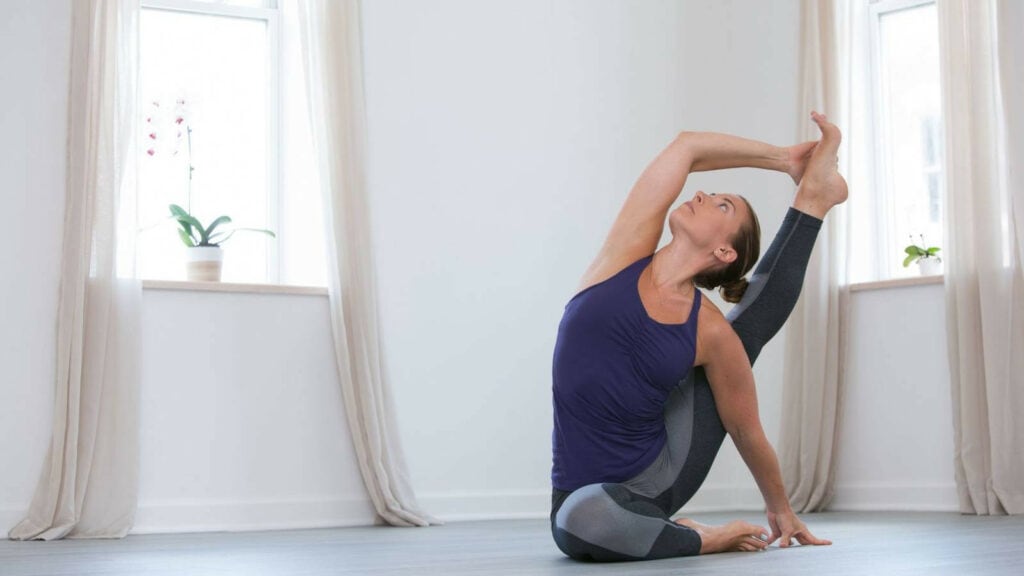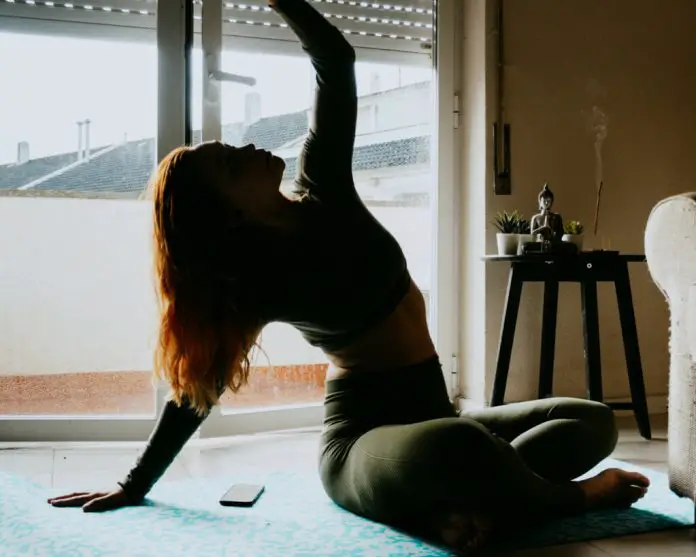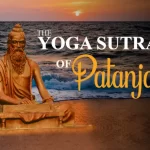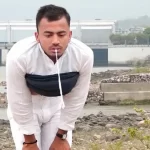Yoga Sitting poses offer a wonderful way to gradually awaken the body in the morning or indulge in deep, satisfying stretches after a vigorous workout. This category of yoga asanas encompasses a variety of forward folds, twists, hip openers, hamstring stretches, and more, providing a comprehensive full-body stretch without the need to stand up.
However, it’s important to note that not all seated poses are inherently easy. While there are beginner-friendly options that gently stretch and release tension, there are also highly challenging ones, including poses like splits pose, that require advanced flexibility and strength.
Don’t just take my word for it! In the following guide, you’ll explore a diverse range of seated yoga poses, carefully curated to cater to practitioners of all levels, from beginners to advanced practitioners. Discover the transformative benefits of these poses and embark on a journey of exploration and growth in your yoga practice.
When Should You Practice Seated Yoga Postures?
Yoga Sitting plays a crucial role in yoga practice, and their placement within a sequence can vary depending on the specific postures and their difficulty level.
Some seated poses, such as bound angle and hero pose, are often included in the warm-up section of a yoga practice. These gentle poses help to loosen up the body and prepare it for the more dynamic standing poses that follow. They provide an opportunity to open up the hips and create a sense of grounding.
On the other hand, deep hip openers and forward folds are commonly incorporated toward the end of a practice. These seated poses can be used to cool down the body and stretch the muscles after the more active standing poses. They facilitate relaxation and introspection, promoting a sense of calm and release.
When incorporating seated poses into your sequence, it is essential to consider the difficulty level of the asanas. Intermediate and advanced seated postures should be practiced in the second half of the session, once the body is adequately warmed up. This approach helps to minimize the risk of injury and allows for a deeper exploration of these more challenging poses.
By strategically placing seated poses in your sequence, you can create a well-rounded and balanced yoga practice that addresses different aspects of the body, mind, and breath.
Beginner Seated Yoga Poses
New to yoga? No worries! Here are eight beginner-level seated poses that will gently stretch and open your body.
Easy Pose (Sukhasana)
The easy pose, also known as Sukhasana, is a widely practiced cross-legged position commonly used as a starting point in many yoga classes. Unlike the more advanced lotus pose, the easy pose is accessible to most people, involving the simple act of crossing the shins and sitting with a straight and aligned spine.
While the basic leg position already provides a gentle opening for the hips, there are various variations of the easy pose that offer additional benefits. These variations can enhance the stretch and offer variations to suit individual needs and preferences. Some of these variations include:
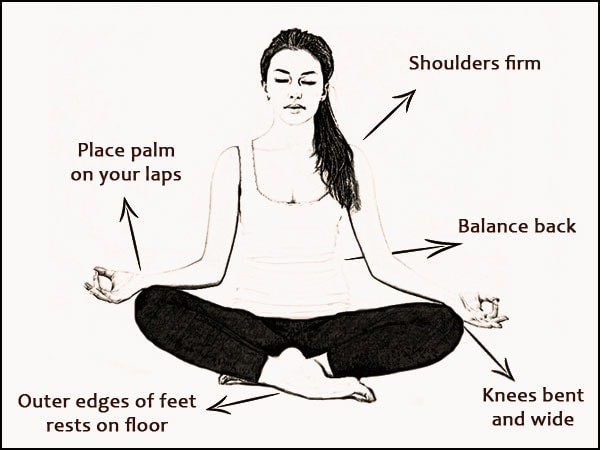
- Gentle twist: With one hand behind you and the other hand on the opposite knee, gently rotate your torso while maintaining a straight spine.
- Gentle forward fold: While keeping your sitting bones grounded, extend your fingertips forward to gradually lower your torso toward your legs.
- Side bend: Place one hand on the floor while reaching the opposite arm up and over to the side, creating a stretch along the side of your body.
- Reverse prayer: Bring both hands behind your back, bending the elbows, and pressing the palms together.
- Chest opener: Clasp your hands behind you and extend your arms. Inhale to open your chest, then exhale as you fold forward, allowing your clasped hands to move up and over.
Bound Angle Pose (Baddha Konasana)
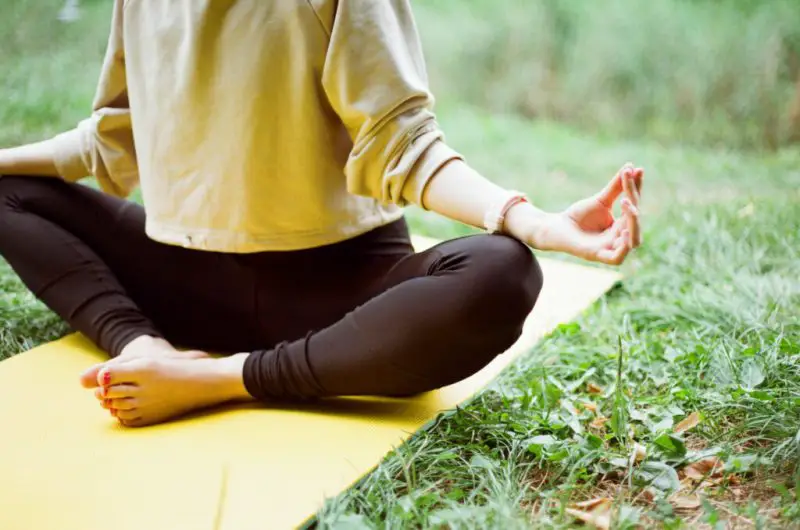
Bound angle pose, also referred to as butterfly or cobbler’s pose, is an asana that targets the inner hip flexors and groin while providing relief for tension in the lower back.
To practice this pose, bend both knees out to the sides, bringing the soles of your feet together. There are several variations you can explore in this position. You can choose to remain upright, gently bounce the knees up and down, or fold forward for a deeper stretch.
The level of sensation you experience in this pose can be adjusted by modifying the distance between your feet and your body. For a gentle stretch, you can bring the feet further away, creating a diamond shape with your legs. On the other hand, pulling the feet closer to your groin will result in a deeper hip opening.
By exploring these variations and adjusting the position of your feet, you can customize the bound angle pose to suit your individual needs and the desired intensity of the stretch. Remember to listen to your body and find a comfortable range of motion that allows you to experience the benefits of this pose while maintaining proper alignment.
Staff Pose (Dandasana)
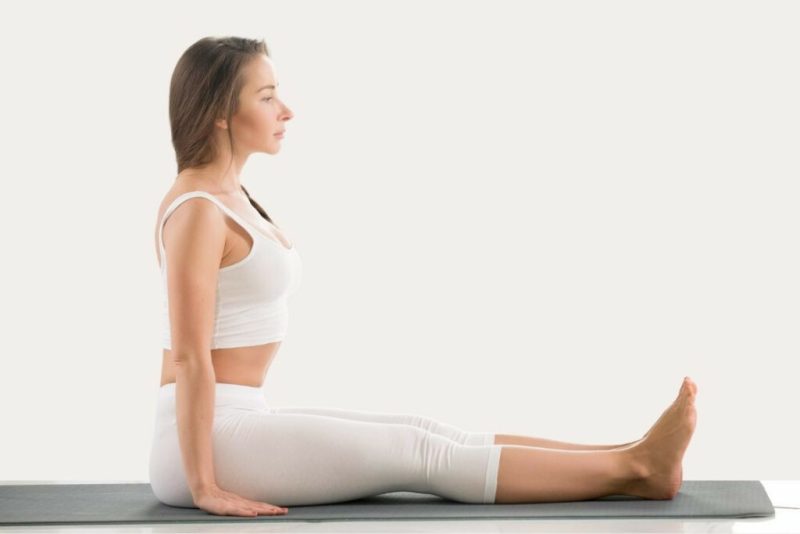
Staff pose, also known as Dandasana, is a beginner seated position in which both legs are extended straight with the feet together and toes pointing upward. This pose offers benefits such as improved posture, elongated spine and hamstrings, and strengthening back muscles.
Although it may appear simple, there is significant muscle engagement required to maintain this posture. To sustain the position, flex your feet and activate your thigh muscles, pressing them firmly against the mat. Additionally, engage your arms by keeping them straight, pressing the palms slightly into the floor, and drawing the shoulders away from the ears.
By actively engaging these muscles and maintaining proper alignment, you can maximize the benefits of Dandasana. Embrace the sense of grounding and lengthening as you find stability and strength within this seemingly straightforward seated pose.
Thunderbolt pose (Vajrasana)
The thunderbolt pose, also known as Vajrasana, is a seated posture where you sit on your heels with your knees deeply flexed. This pose provides a stretch for the quadriceps while also strengthening various parts of the body, including the ankles, knees, back, chest, and core.
Aside from its physical benefits, the thunderbolt pose is commonly used for seated meditation and practicing breathing techniques. Moreover, it offers numerous therapeutic advantages, such as aiding digestion, relieving constipation, and managing hypertension.
By assuming the thunderbolt pose, you can experience the combined effects of stretching, strengthening, and therapeutic benefits. Embrace this seated posture as a means to enhance your overall well-being and delve deeper into the realms of meditation and breathwork.
Head To Knee Pose (Janu Sirsasana)
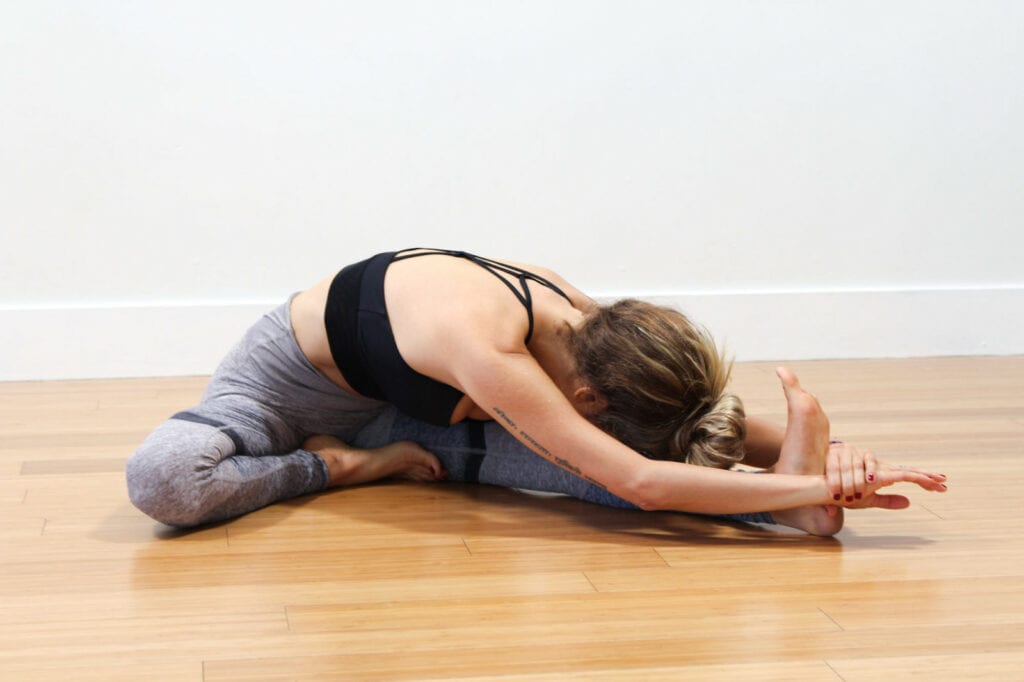
This seated yoga posture combines the elements of a forward bend and a hip opener. It provides a stretch to various parts of the body, including the spine, hamstrings, groins, and shoulders. Additionally, it stimulates specific organs such as the liver and spleen, while inducing a calming sensation in the mind.
To practice this pose, begin in a seated position with both legs extended straight. Then, bend your right knee, rotating it outward and placing the foot on the inner left thigh. Maintain an upright posture, inhale, and fold forward over the extended leg.
During the pose, focus on drawing your chest forward toward your foot. Flexing the left foot will help keep the leg straight and deepen the stretch in the hamstrings. If you can reach your foot with your fingers, gently pull yourself further toward the left leg to enhance the stretch.
By immersing yourself in this pose and embracing the alignment cues, you can fully experience the stretch and benefits it offers. Allow your breath to guide you as you find depth and openness in this seated yoga posture.
Seated Spinal Twist (Half Lord Of The Fishes Pose)
The seated spinal twist is a highly therapeutic pose for the digestive system. Its deep twisting position effectively “wrings out” the abdominal organs, promoting the release of toxins, stimulating digestion, and toning the core. Additionally, this pose improves spinal mobility and provides relief from low back pain.
To practice the seated spinal twist, begin by sitting with both legs extended straight. Then, bend your left knee and place the foot on the outside of your right thigh. Bend your right knee, bringing the foot towards your left hip while keeping the knee grounded. If this leg position is not accessible or causes discomfort, you can keep the bottom leg straight.
Maintaining the leg position, place your left hand behind you with the fingertips on the ground, using the wrist to support your lower back. Inhale and raise your right arm upward, then exhale and twist your spine to the left. Bend your right elbow and hook it onto the outside of the left knee. Hold this position for five breaths, gradually deepening the twist with each exhale.
As you practice this seated spinal twist, focus on the breath and allow it to guide you deeper into the twist. Embrace the gentle stretching and twisting sensation while keeping awareness of any discomfort or pain. By consistently practicing this pose, you can experience its therapeutic benefits and enhance your overall well-being.
This intermediate yoga pose stretches the hamstrings deeply, opens the hips, and increases spinal flexibility. It also strengthens the feet, knees, and ankles while stimulating the heart and abdominal organs.
Bend your left knee from Dandasana, bringing the foot next to your left sitting bone (as in a half Hero position). Then, with your right knee bent, place the sole of your foot on the floor in front of you.
With both hands, grab your right foot and steadily extend and lift the leg, bringing the foot higher than the head. You may need to lean back somewhat but keep your spine straight and your chest high.
Advanced Seated Yoga Poses
Mastered all of the above? Then give these challenging advanced-level seated yoga poses a go if you feel brave enough. Just be sure to fully warm up the body before attempting them.
Lotus Pose (Padmasana)
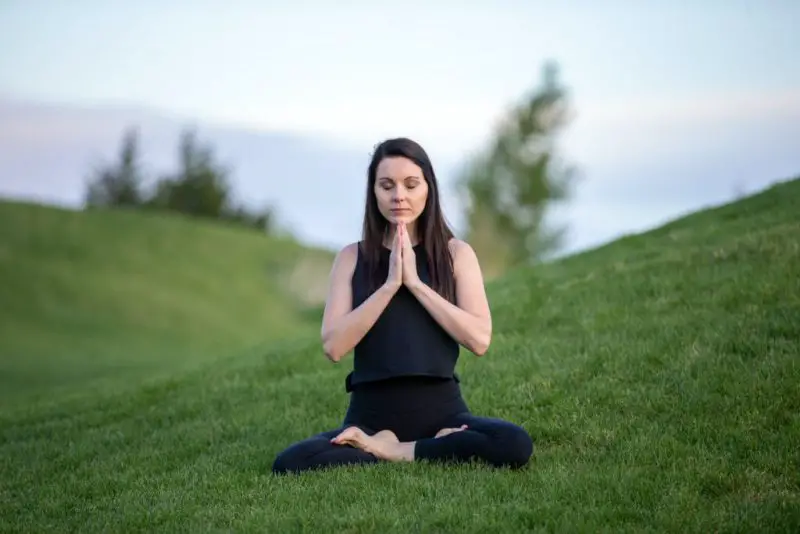
Lotus stance is commonly depicted as the traditional meditation posture, however, it is quite difficult for many individuals due to the considerable hip flexibility required. This pose increases flexibility, promotes good posture, relaxes the mind, and stretches the ankles and knees.
Lift the left foot from an easy position and steadily glide it towards the right thigh, placing it near to the groin with the sole pointing up. This is referred to as the half-lotus stance.
Release the right leg, grab the foot, and cross the shins to position the right foot on the left thigh for the final version. Both soles should be facing upwards in the final position, and the heels should be close to each other.
Tortoise Pose (Kurmasana)
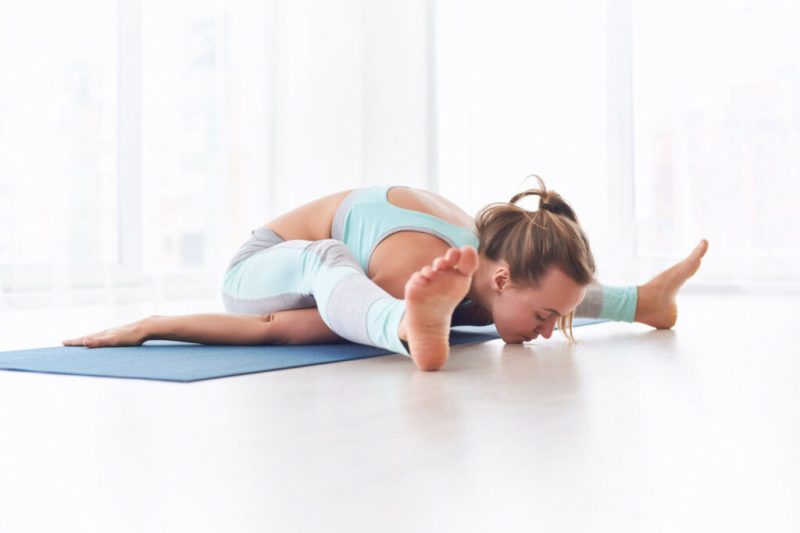
Tortoise Pose is one of the most difficult seated yoga positions because it involves open hips and spine and shoulder flexibility. It does, however, provide several benefits, including abdominal organ toning, lowering low back stress and sciatica pain, and boosting blood circulation.
Bend your knees slightly as you walk your hands forward between the legs from a straddle position with your legs wide and your back straight. Slide your arms between your knees with your palms facing down as you descend your upper body between your legs. The full expression is to stretch the legs and flatten the arms and torso to the ground.
Full Splits (Hanumanasana)
Hanumanasana, often known as complete splits, is another difficult seated posture for many people because it needs very open hips and thighs. However, it offers numerous benefits, including leg toning, menstrual cramp relief, and nervous system balance.
Step your left foot between your hands from a tabletop position. Next, walk the foot forward while sinking your hips and sliding your right leg back, bringing the feet further apart. The left foot can then be flexed to glide the heel along the floor, putting the hips as near to the ground as possible.
If your sitting bones remain elevated above the floor, place a block beneath them for support.
Compass Pose (Parivrtta Surya Yantrasana)
